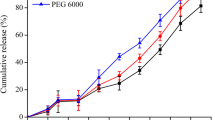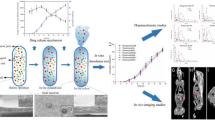Abstract
In this work, self-double-emulsifying drug delivery system enteric-coated capsules (PNS-SDE-ECC) were used to enhance the oral bioavailability and anti-inflammatory effects of Panax notoginseng saponins (PNS), which are rapidly biodegradable, poorly membrane permeable, and highly water-soluble compounds. The PNS-SDEDDS formulated by a modified two-step method spontaneously emulsified to W/O/W double emulsions in the outer aqueous solution, which significantly promoted the absorption of PNS in the intestinal tract. The release study revealed that PNS-SDE-ECC exhibited sustained release of PNS within 24 h and the stability study indicated that PNS-SDE-ECC were stable at room temperature for up to 3 months. Furthermore, compared to PNS gastric capsules, the relative bioavailability of NGR1, GRg1, GRe, GRb1, and GRd in PNS-SDE-ECC was increased by 4.83, 10.78, 9.25, 3.58, and 4.63 times, respectively. More importantly, PNS-SDE-ECC significantly reduced OXZ-induced inflammatory damage in the colon by regulating the expression of TNF-α, IL-4, IL-13, and MPO cytokines. Overall, the prepared PNS-SDE-ECC may serve as a viable vehicle for increasing the oral bioavailability of PNS and its anti-inflammatory action on ulcerative colitis.
Graphical Abstract











Similar content being viewed by others
Data Availability
The data that support the findings of this study are available from the corresponding author upon reasonable request.
References
Qu J, Xu N, Zhang J, Geng X, Zhang R. Panax notoginseng saponins and their applications in nervous system disorders: a narrative review. Ann Transl Med. 2020;8:1525.
Zhao H, Han Z, Li G, Zhang S, Luo Y. Therapeutic potential and cellular mechanisms of panax notoginseng on prevention of aging and cell senescence-associated diseases. Aging Dis. 2017;8:721–39.
Yang X, Xiong X, Wang H, Wang J. Protective effects of panax notoginseng saponins on cardiovascular diseases: a comprehensive overview of experimental studies. Evid Based Complement Alternat Med. 2014;2014: 204840.
Liu J, Wang Y, Qiu L, Yu Y, Wang C. Saponins of Panax notoginseng: chemistry, cellular targets and therapeutic opportunities in cardiovascular diseases. Expert Opin Investig Drugs. 2014;23:523–39.
Zhang ZJ, Chen LJ, Cui XM, Zhang YM, Hu YP, Wang CX, et al. Identification of anti-inflammatory components of raw and steamed Panax notoginseng root by analyses of spectrum-effect relationship. RSC Adv. 2019;9:17950–8.
Li J, Wang RF, Zhou Y, Hu HJ, Yang YB, Yang L, et al. Dammarane-type triterpene oligoglycosides from the leaves and stems of Panax notoginseng and their antiinflammatory activities. J Ginseng Res. 2019;43:377–84.
Liu MW, Huang YQ, Qu YP, Wang DM, Tang DY, Fang TW, et al. Protective effects of Panax notoginseng saponins in a rat model of severe acute pancreatitis occur through regulation of inflammatory pathway signaling by upregulation of miR-181b. Int J Immuopath Ph. 2018;32:1–19.
He Y, Li H, Zheng X, Yuan M, Yang R, Yuan M, et al. Preparation, in vivo and in vitro release of polyethylene glycol monomethyl ether-polymandelic acid microspheres loaded Panax notoginseng saponins. Molecules. 2019;24:2024.
Kim H, Lee JH, Kim JE, Kim YS, Ryu CH, Lee HJ, et al. Micro-/nano-sized delivery systems of ginsenosides for improved systemic bioavailability. J Ginseng Res. 2018;42:361–9.
Xu Q, Fang XL, Chen DF. Pharmacokinetics and bioavailability of ginsenoside Rb1 and Rg1 from Panaxnotoginseng in rats. J Ethnopharmacol. 2003;84:187–92.
Li X, Wang G, Sun J, Hao H, Xiong Y, Yan B, et al. Pharmacokinetic and absolute bioavailability study of total Panax notoginsenoside, a typical multiple constituent traditional chinese medicine (TCM) in rats. Biol Pharm Bull. 2007;30:847–51.
Joo KM, Lee JH, Jeon HY, Park CW, Hong DK, Jeong HJ, et al. Pharmacokinetic study of ginsenoside Re with pure ginsenoside Re and ginseng berry extracts in mouse using ultra performance liquid chromatography/mass spectrometric method. J Pharm Biomed Anal. 2010;51:278–83.
Feng L, Hu CJ, Yu LY. Pharmacokinetics of ginsenosides Rg1 and its metabolites in rats. Acta Pharm Sin. 2010;45:636–40.
Fu W, Liang Y, Xie Z, Wu H, Zhang Z, Lv H. Preparation and evaluation of lecithin/zein hybrid nanoparticles for the oral delivery of Panax notoginseng saponins. Eur J Pharm Sci. 2021;164: 105882.
Zhang J, Han XZ, Li X, Luo Y, Zhao HP, Yang M, et al. Core-shell hybrid liposomal vesicles loaded with panax notoginsenoside: preparation, characterization and protective effects on global cerebral ischemia/reperfusion injury and acute myocardial ischemia in rats. Int J Nanomedicine. 2012;7:4299–310.
Liu ZD, Zhang Q, Ding LL, Li CH, Yin ZP, Yan GQ, et al. Preparation procedure and pharmacokinetic study of water-in-oil nanoemulsion of Panax notoginseng saponins for improving the oral bioavailability. Curr Drug Deliv. 2016;13:600–10.
Hu C, Wang Q, Zhao G, Yao W, Xia Q. Improved oral absorption of (−)-epigallocatechin-3-gallate via self-double-emulsifying solid formulation. Eur J Lipid Sci Technol. 2015;118: 111524.
Wang Q, Hu C, Qian A, Liu T, Zhang H, Zhang Y, et al. Enhanced oral bioavailability of quercetin by a new non-aqueous self-double-emulsifying drug delivery system. Eur J Lipid Sci Technol. 2016;119:1600167.
Wang X, Jiang S, Wang X, Liao J, Yin Z. Preparation and evaluation of nattokinase-loaded self-double-emulsifying drug delivery system. Asian J Pharm Sci. 2015;10:386–95.
Qi X, Wang L, Zhu J, Hu Z, Zhang J. Self-double-emulsifying drug delivery system (SDEDDS): a new way for oral delivery of drugs with high solubility and low permeability. Int J Pharm. 2011;409:245–51.
Bhattacharjee A, Verma S, Verma PRP, Singh SK, Chakraborty A. Fabrication of liquid and solid self-double emulsifying drug delivery system of atenolol by response surface methodology. J Drug Deliv Sci Tec. 2017;41:45–57.
Lv LZ, Tong CQ, Lv Q, Tang XJ, Li LM, Fang QX, et al. Enhanced absorption of hydroxysafflor yellow A using a self-double-emulsifying drug delivery system: in vitro and in vivo studies. Int J Nanomedicine. 2021;7:4099–107.
Chen L, Han X, Xu X, Zhang Q, Zeng Y, Su Q, et al. Optimization and evaluation of the thermosensitive in situ and adhesive gel for rectal delivery of budesonide. AAPS PharmSciTech. 2020;21:97.
Aggarwal A, Sabol T, Vaziri H. Update on the use of biologic therapy in ulcerative colitis. Curr Treat Options Gastroenterol. 2017;15:155–67.
Burri E, Maillard MH, Schoepfer AM, Seibold F, Van Assche G, Rivière P, et al. Treatment algorithm for mild and moderate-to-severe ulcerative colitis: an update. Digestion. 2020;101:2–15.
Anindya AL, Oktaviani RD, Praevina BR, Damayanti S, Kurniati NF, Riani C, et al. Xylan from pineapple stem waste: a potential biopolymer for colonic targeting of anti-inflammatory agent mesalamine. AAPS PharmSciTech. 2019;20:112.
Yu C, Li C, Pan H, Li T, He S. Preparation of 2-methoxyestradiol self-emulsified drug delivery system and the effect on combination therapy with doxorubicin against MCF-7/ADM cells. AAPS PharmSciTech. 2022;23(5):147.
Chidambaram N, Burgess DJ. A novel in vitro release method for submicron sized dispersed systems. AAPS PharmSciTech. 1999;1(3):E11.
Zhang LH, Cao N, Wang YW, Wang YX, Wu C, Cheng XM, et al. Improvement of oxazolone-induced ulcerative colitis in rats using andrographolide. Molecules. 2019;25:74.
Matsuzawa A, Morishita M, Takayama K, Nagai T. Absorption of insulin using water-in-oil-in-water emulsion from an enteral loop in rats. Biol Pharm Bull. 1995;18(12):1718–23.
Onuki Y, Morishita M, Takayama K. Formulation optimization of water-in-oil-water multiple emulsion for intestinal insulin delivery. J Control Release. 2004;97(1):91–9.
Wilson TH, Wisenman G. The use of sacs of everted small intestine for the study of the transference of substances from the mucosal to the serosal surface. J Physiol. 1954;123(1):116–25.
Barthe L, Woodley J, Houin G. Gastrointestinal absorption of drugs: methods and studies. Fundam Clin Pharmacol. 1999;13(2):154–68.
Jin D, Wang B, Hu R, Su D, Chen J, Zhou H, et al. A novel colon-specific osmotic pump capsule of Panax notoginseng saponins (PNS): formulation, optimization, and in vitro-in vivo evaluation. AAPS PharmSciTech. 2018;19(5):2322–9.
Karikura M, Miyase T, Tanizawa H, Taniyama T, Takino Y. Studies on absorption, distribution, excretion and metabolism of ginseng saponins. VII. Comparison of the decomposition modes of ginsenoside-Rb1 and -Rb2 in the digestive tract of rats. Chem Pharm Bull (Tokyo). 1991;39(9):2357–61.
Wang Z, Zhao Z, Khan NR, Hua Z, Huo J, Li Y. Microwave assisted chitosan-polyethylene glycol hydrogel membrane synthesis of curcumin for open incision wound healing. Pharmazie. 2020;75(4):118–23.
Bachhav YG, Patravale VB. SMEDDS of glyburide: formulation, in vitro evaluation, and stability studies. AAPS PharmSciTech. 2009;10:482–7.
Parmar N. Study of cosurfactant effect on nanoemulsifying area and development of lercanidipine loaded (SNEDDS) self nanoemulsifying drug delivery system. Colloids Surf B Biointerfaces. 2011;86:327–38.
Zhao J, Su C, Yang C, Liu M, Tang L, Su W, et al. Determination of ginsenosides Rb1, Rb2, and Rb3 in rat plasma by a rapid and sensitive liquid chromatography tandem mass spectrometry method: application in a pharmacokinetic study. J Pharmaceut Biome Anal. 2012;64–65:94–7.
Chen W, Dang Y, Zhu C. Simultaneous determination of three major bioactive saponins of Panax notoginseng using liquid chromatography-tandem mass spectrometry and a pharmacokinetic study. Chin Med. 2010;5:12.
Liu HF, Yang JL, Du FF, Gao XM, Ma XT, Huang YH, et al. Absorption and disposition of ginsenosides after oral administration of Panax notoginseng extract to rats. Drug Metab Dispos. 2009;37:2290–8.
Kasaian MT, Page KM, Fish S, Brennan A, Cook TA, Moreira K, et al. Therapeutic activity of an interleukin-4/interleukin-13 dual antagonist on oxazolone-induced colitis in mice. Immunology. 2014;143:416–27.
Randhawa PK, Singh K, Singh N, Jaggi AS. A review on chemical-induced inflammatory bowel disease models in rodents. Korean J Physiol Pharmacol. 2014;18:279–88.
Axelsson LG, Landström E, Bylund-Fellenius AC. Experimental colitis induced by dextran sulphate sodium in mice: beneficial effects of sulphasalazine and olsalazine. Aliment Pharmacol Ther. 1998;12:925–34.
Sun AN, Ren GY, Deng C, Zhang JL, Luo XP, Wu XJ, et al. C-glycosyl flavonoid orientin improves chemically induced inflammatory bowel disease in mice. J Funct Foods. 2016;21:418–30.
West GA, Matsuura T, Levine AD, Klein JS, Fiocchi C. Interleukin 4 in inflammatory bowel disease and mucosal immune reactivity. Gastroenterology. 1996;110:1683–95.
Wang X, Ouyang Q, Luo WJ. Oxazolone-induced murine model of ulcerative colitis. Chin J Dig Dis. 2004;5:165–8.
Dames P, Bergann T, Fromm A, Bücker R, Barmeyer C, Krug SM, et al. Interleukin-13 affects the epithelial sodium channel in the intestine by coordinated modulation of STAT6 and p38 MAPK activity. J Physiol. 2015;593:5269–82.
Heller F, Florian P, Bojarski C, Richter J, Christ M, Hillenbrand B, et al. Interleukin-13 is the key effector Th2 cytokine in ulcerative colitis that affects epithelial tight junctions, apoptosis, and cell restitution. Gastroenterology. 2005;129:550–64.
Rosen MJ, Chaturvedi R, Washington MK, Kuhnhein LA, Moore PD, Coggeshall SS, et al. Stat6 deficiency ameliorates severity of oxazolone colitis by decreasing expression of claudin-2 and Th2-inducing cytokines. J Immunol. 2013;190:1849–58.
Acknowledgements
The authors would like to thank the Shanghai University of Traditional Chinese Medicine Ethics Committee for their kind guidance in the animal experiments, the Shanghai University of Traditional Chinese Medicine for providing the technical platform, and the Guangxi Wuzhou Pharmaceutical (Group) Co., Ltd for providing funding support.
Funding
This work was supported by Guangxi Wuzhou Pharmaceutical (Group) Co., Ltd. (E4-D200004).
Author information
Authors and Affiliations
Contributions
Yaru Wang performed most of the experiments and data collection, analyzed the data, and wrote the manuscript. Yunxia Shang, Fengyu Tang, and Kun Qiu participated in completing the study of the ulcerative colitis experiment. Xiaohui Wei designed the experiments, supervised the study, and contributed to the finalizing of the manuscript. Zhengtao Wang provided valuable comments on the experimental design. All authors reviewed the manuscript and agreed to the published version of the manuscript.
Corresponding author
Ethics declarations
Conflict of Interest
The authors declare no competing interests.
Additional information
Publisher's Note
Springer Nature remains neutral with regard to jurisdictional claims in published maps and institutional affiliations.
Supplementary Information
Below is the link to the electronic supplementary material.
Rights and permissions
Springer Nature or its licensor (e.g. a society or other partner) holds exclusive rights to this article under a publishing agreement with the author(s) or other rightsholder(s); author self-archiving of the accepted manuscript version of this article is solely governed by the terms of such publishing agreement and applicable law.
About this article
Cite this article
Wang, Y., Shang, Y., Tang, F. et al. Self-Double-Emulsifying Drug Delivery System Enteric-Coated Capsules: A Novel Approach to Improve Oral Bioavailability and Anti-inflammatory Activity of Panax notoginseng Saponins. AAPS PharmSciTech 24, 90 (2023). https://doi.org/10.1208/s12249-023-02549-0
Received:
Accepted:
Published:
DOI: https://doi.org/10.1208/s12249-023-02549-0




